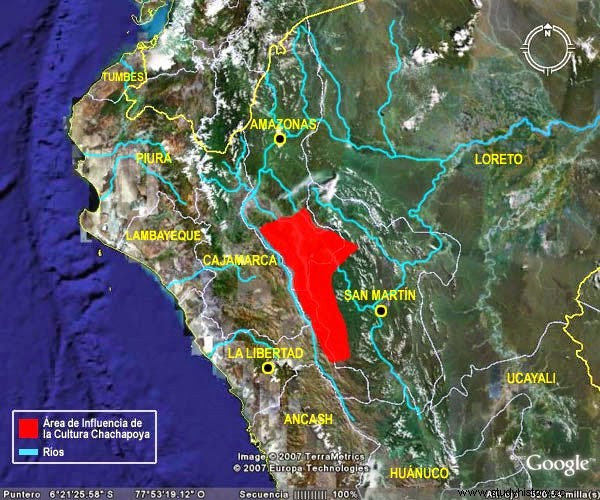 Map of territorial location of the Chachas
Map of territorial location of the Chachas ETYMOLOGY
- Kuelap: "cold place" (in native language)
- Chachapoya: "People of the clouds" chacha=people / phuyas=clouds (in Aymara)
- Chachapoya: "Trees in the clouds" sacha=tree / puyas=clouds (in Quechua)
- Inca Garcilazo de la Vega: Chachapoyas ="place of strong men".
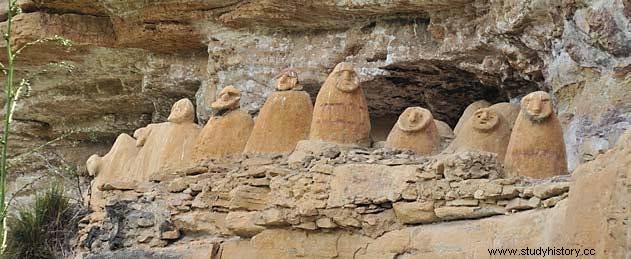 The view of the Ayachaqui sarcophagi is oriented towards the west
The view of the Ayachaqui sarcophagi is oriented towards the west QUOTES FROM THE CHRONICLERS Many of the Spanish chroniclers such as Cieza de León (1554), Sarmiento de Gamboa (1572), Acosta (1590) or Garcilaso de la Vega (1609) mention the province of Chachapoyas at the time of the Spanish conquest, with brief descriptions. The chroniclers characterized the natives of northeastern Peru as belonging to an ethnic group, the Chachapoyas, known for their beautiful white-skinned women and for their resistance to the Incas, who at that time had occupied the region for little more than half a century. .
ABOUT THE BEAUTY OF WOMEN:" The whiteness and beauty of the Chachapoya is a fact that caught the attention of numerous chroniclers and explorers. Pedro Cieza de León wrote in one of his chronicles:"...these native Indians of Chachapoyas are the whitest and most graceful of all those I have seen in the Indies that I have traveled, and their women were so beautiful that for their kindness alone many of them deserved to be from the Incas and to be taken to the temples of the sun...".
ABOUT TEXTILES:" Pedro Cieza de León comments that the Chachapoyas "...made rich and precious clothing for the Inca, and today they make it very premium and very fine and showy upholstery, which is highly regarded for its beauty..."
ABOUT THE CLOTHING AND ITS MAIN GOD: "Pedro Cieza says that the Chachapoya "...are dressed in woolen clothes and have large herds of sheep, worship snakes and have the condor as their main god."
ABOUT THE GEOGRAPHY OF THE PLACE: "Vásquez de Espinoza says about the Chachapoya territory:"...a very rich and very fertile land... many gold mines of great wealth" (1629).
HISTORY, ORIGIN AND LEGEND OF THE CHACHAPOYAS The history of the Chachapoyas begins around the year 800 AD and lasted until the second half of the fifteenth century, when they were incorporated by Túpac Yupanqui into Tahuantinsuyo. The physical features of the inhabitants of the province of Rodríguez de Mendoza, in the department of Amazonas, are striking. In this regard, archaeologist Federico Kauffmann says:"the presence of gringuitos, relatively abundant in the Huayabamba basin, has fueled speculation about the Viking origin of the Chachapoyas" . For his part, the explorer Gene Savoy maintains that this is the consequence of an ancient Viking migration through the Amazon.Legend has it that the Inca ruler Huayna Cápac, after pardoning the people of Cajamarquilla after a failed rebellion, he felt sick and went to Atuén; there he stayed for a year to try to heal himself with the medicinal waters of the lake and with the help of local healers. Several Spanish chroniclers mention the Chachapoya as great sorcerers, doctors and magicians. Even today, healers from the coast travel to Atuén to collect certain medicinal herbs. In a process from the year 1574, one of the witnesses tells a very interesting story:when he was transferred sick to Quito, Huayna Capac received certain medicinal herbs from one of the chiefs of Cochabamba, but died as a result of intoxication. The Inca captain Colla Topa abandoned the funeral procession of Huayna Cápac on the way to Cusco and left Cajamarca for Cochabamba where he accused the cacique of having poisoned the Inca. However, the cacique had already died. Colla Topa then ordered that the bones of the deceased be lowered from "some cliffs where they placed their most important dead", ordering that they be buried. This fact is in perfect agreement with archaeological investigations," says Inge Schjellerup
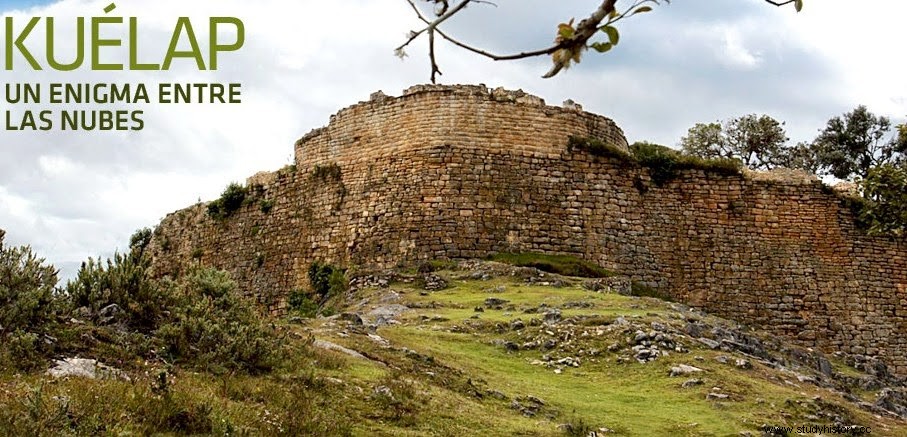
POLITICS AND SOCIETY The unit of social organization was made up of large provinces, each controlled by a powerful cacique and totally independent of each other. They were small kingdoms or lordships settled mainly on the banks of the Utcubamba River. They all had the same language, the same customs and ways of farming and, very occasionally, they would get together for some religious ceremonies or to defend themselves from the attack of an enemy people, always maintaining their autonomy.
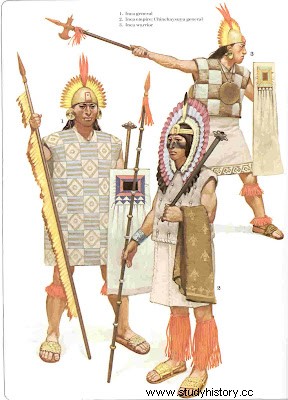 Warriors According to the chronicles related by Pedro Cieza de León, the Chachapoyas were the whitest and most graceful of all the inhabitants of Peru. They wore woolen clothes and carried “llautos” on their heads as a sign of their origin. After their annexation to the Inca, they adopted the customs imposed by the people of Cusco. The social organization was based on domestic production and agricultural subsistence with storage facilities. The population of Chachapoyas may have had the position of mediators in a short and long distance chain in the network of exchanges between prestige, and in symbolic valuation of products and articles they were undoubtedly in contact with the Xibitos at the top of the group. of the low land which was a chain to the East side. The exchange of food, for example salt, and services within the Chachapoyas region was based on social relations where work networks unite populations in alliance.
Warriors According to the chronicles related by Pedro Cieza de León, the Chachapoyas were the whitest and most graceful of all the inhabitants of Peru. They wore woolen clothes and carried “llautos” on their heads as a sign of their origin. After their annexation to the Inca, they adopted the customs imposed by the people of Cusco. The social organization was based on domestic production and agricultural subsistence with storage facilities. The population of Chachapoyas may have had the position of mediators in a short and long distance chain in the network of exchanges between prestige, and in symbolic valuation of products and articles they were undoubtedly in contact with the Xibitos at the top of the group. of the low land which was a chain to the East side. The exchange of food, for example salt, and services within the Chachapoyas region was based on social relations where work networks unite populations in alliance.ECONOMY Agriculture developed taking advantage of access to a variety of ecosystems. The slopes of the hills were transformed into wide cultivation terraces and the lowlands were cultivated fields with elaborate drainage systems. :In addition, they based their economy on the domestic production of ceramics and textiles, in this way the production and exchange of food helped to consolidate social networks and alliances between the Populations.
CULTURAL MANIFESTATIONS
A. ARCHITECTURE. The central zone of the development of the Chachapoyas culture was the Utcubamba basin. There we can find the architectural ensembles of Olán, Yalapé, Purunllacta or "Monte Peruvia", Congón (renamed Gran Vilaya), Vira Vira, Pajatén and others. But Cuélap is, without a doubt, the greatest monument, almost 600 meters long and walls that reach 20 meters high. Chachapoyas architecture is characterized by large stone constructions, circular in shape, decorated with friezes and defensive walls. Residential and monumental constructions are circular with high bases, large stone cornices and flat stones protruding from the surface of the bases. They have inclined ramps or stairs, directed towards the entrance. The Chachapoyas developed a common symbolic language with geometric motifs in the form of triangles, rhombuses, serpentine and square ornaments, which appear in the stone friezes of the circular houses. These symbols had an ethnic and social value, and served to demonstrate the strength of local identity, maintained through the Inca period.
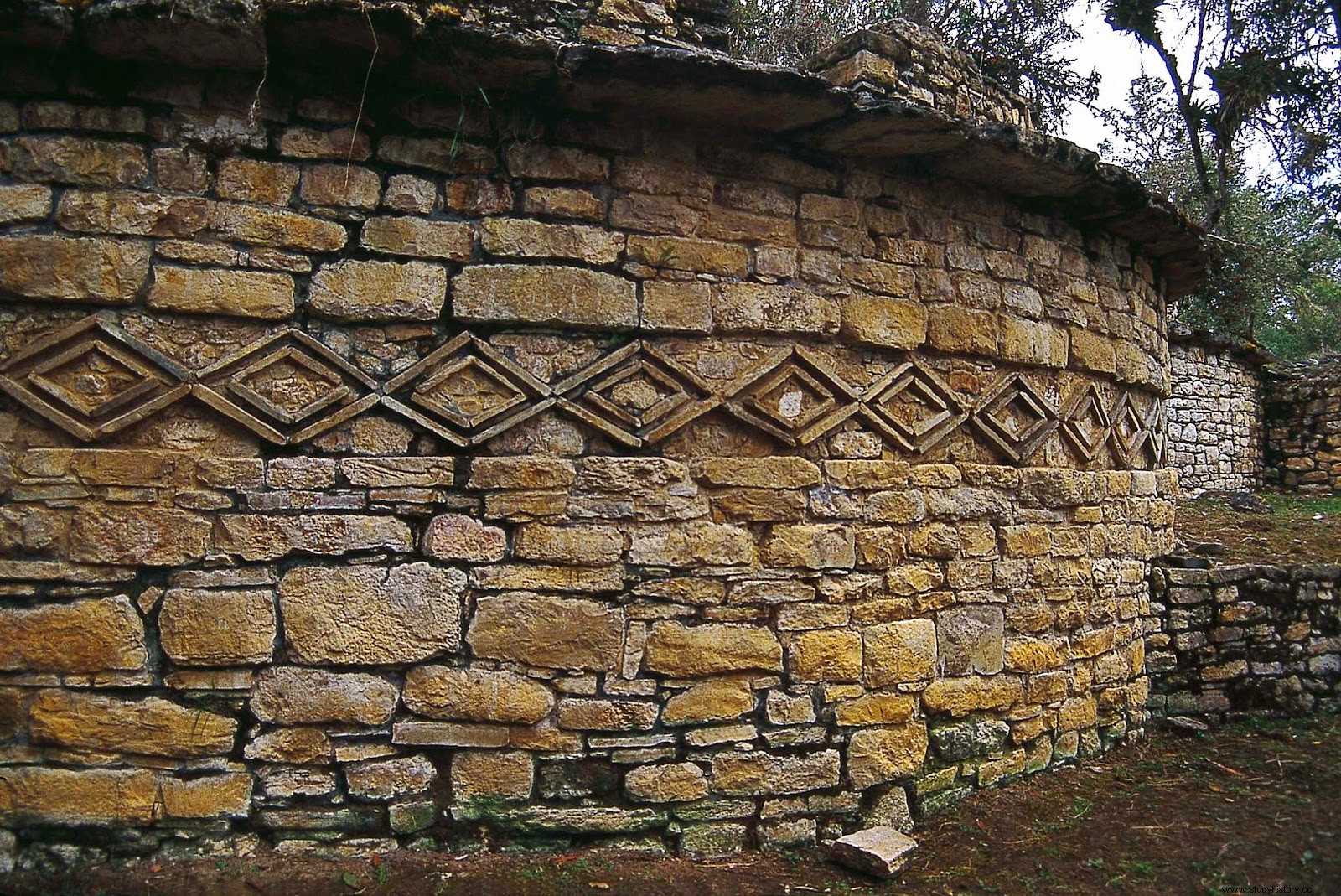 EXAMPLE OF FRIEZES. The diamond friezes are
EXAMPLE OF FRIEZES. The diamond friezes are frequently repeated in the iconography of
Chachapoyas. KUELAP It is located in an inaccessible place at an altitude of 3,000 meters and about 25 km. southwest of Chachapoyas, in the district of Tingo. It is a fortified complex of approximately 450 hectares, made up of different sectors, the most important being Fortress. Around this citadel you can see an impressive wall of approximately 30 m. high and 600 m. long. Inside there are generally circular buildings built of stone with a detailed, aesthetic technique, decorated with rhomboid friezes and anthropomorphic figures in high relief. They were officially made known in 1834, by Judge Juan Crisóstomo Nieto (discoverer)
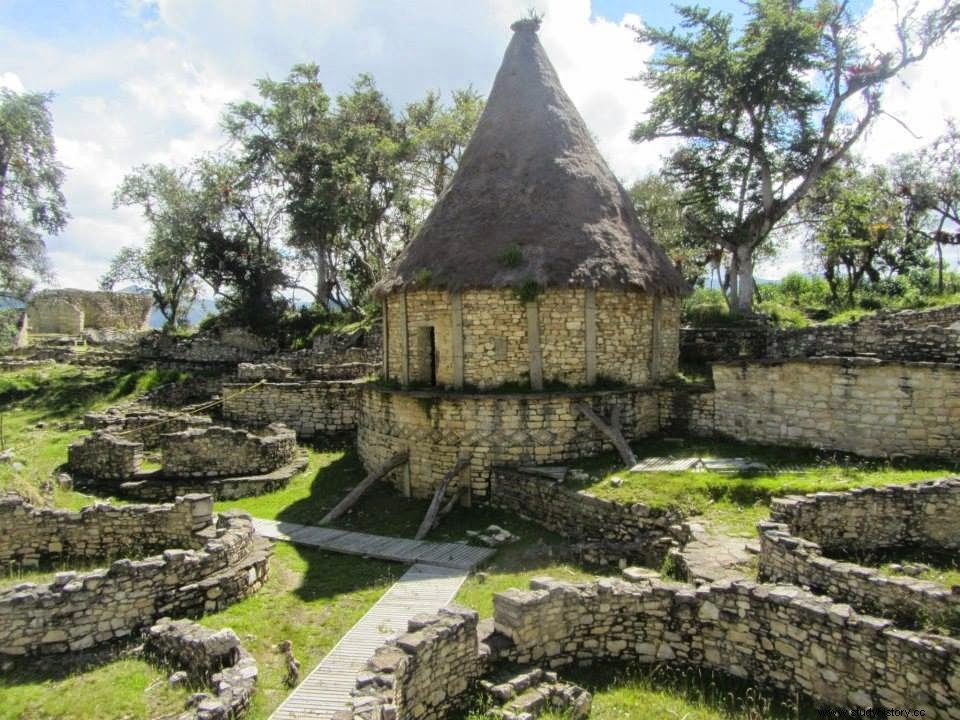
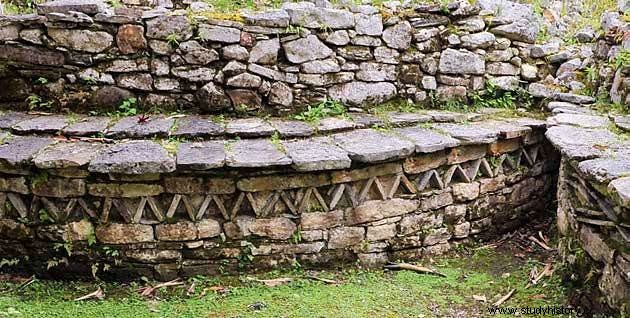 This decoration can also be found in the Kuelap architectural complex. GREAT PAJATEN The Pajatén complex is located on a narrow plateau at the confluence of two of the tributary rivers of the Abiseo River. This hill is 2850 meters above sea level, and 93 km. northeast of the town of Pataz. The architectural remains are made up of twenty structures, most of them with a circular floor plan built with stone walls, located at different levels. The walls are not straight, but have rounded shapes. Access to the temples was from stairs located on the west side of the temples. The three largest buildings have a diameter of about 15 m.
This decoration can also be found in the Kuelap architectural complex. GREAT PAJATEN The Pajatén complex is located on a narrow plateau at the confluence of two of the tributary rivers of the Abiseo River. This hill is 2850 meters above sea level, and 93 km. northeast of the town of Pataz. The architectural remains are made up of twenty structures, most of them with a circular floor plan built with stone walls, located at different levels. The walls are not straight, but have rounded shapes. Access to the temples was from stairs located on the west side of the temples. The three largest buildings have a diameter of about 15 m.
B. FUNERAL CUSTOMS. In the Chachapoyas culture there were two types of funerary treatment:carved stone mausoleums and clay sarcophagi. Both are in practically inaccessible places. The mausoleums were large groups of quadrangular constructions, with gabled roofs, large cornices and quadrangular or T-shaped niches. Among the most important mausoleums are Revash and Usator. On the other hand, the sarcophagi covered the body of the deceased who was squatting and wrapped with tissues, and appeared as a cylindrical or conical vault. Among the groupings of sarcophagi, Chipuric, Petuen, Guan, and Ucaso stand out.
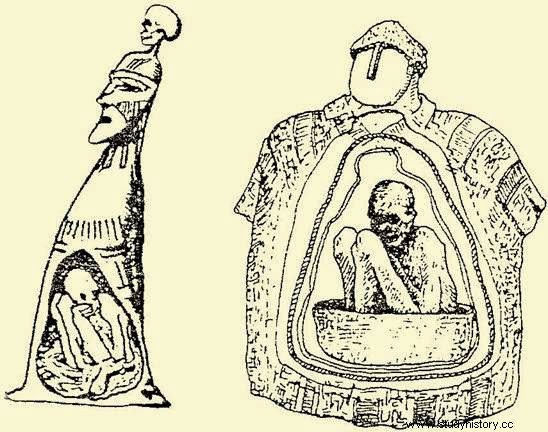 DRAWING OF WARI FUNERARY BUNDLE AND SARCÓPHAGUS
DRAWING OF WARI FUNERARY BUNDLE AND SARCÓPHAGUSOF PURUNMACHO IN UCASO. Note the relationship between the Wari table mask
and the prominent jaw of the sarcophagus.SARCOPHAGES AND MAUSOLEUM In the north of Chachapoyas, most of the sarcophagi are found, such as Carajía, Ayachaqui, Léngate, and the Pueblo de los Muertos, while in the south, most of the mausoleums are found. And what all these funeral sites have in common is their situation. They are found in isolated places and at the top of mountain precipices, most of them inaccessible, in caves or galleries. Most of the caves and galleries were made especially for the construction of these funerary places.
KARAJIA It constitutes one of the sites of pre-Inca sarcophagi, which are located in a cave excavated at the top of a precipice of several hundred meters, which is located in a small valley with high and steep walls, in the Marañón basin, department of Amazon. These sarcophagi were found in August 1985 with no signs of ever having been desecrated, precisely because they were found in an almost inaccessible place at a height of 2,702 meters. The sarcophagi reach up to 2.40 meters in height and were made by making thick walls of clay mixed with wild straw, which are preserved thanks to a frame of wood, reeds and stones. Until today six have been preserved. individual tombs, placed in a row and stuck on their sides next to each other. «It is made up of a clay capsule that houses a mummy, squatting, wrapped in cloth and sitting [...] on an animal hide. Various objects such as ceramic containers and utensils used in textile art appear around the mummified deceased, as offerings, perhaps selected among the garments he had in life. The “capsules” do not abound in offerings” (Kauffmann Doig 2003:208). Thus, each sarcophagus housed a person and the radiocarbon dating obtained, after the analysis of a piece of wood from one of the collapsed sarcophagi, allows the Carajía sarcophagi to be traced back to the year 1460 AD. C
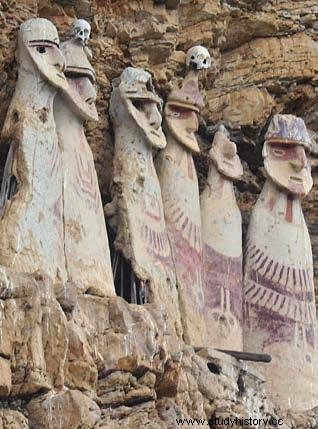 Archaeologist Federico Kauffman Doig next to the Karajia sarcophagi
Archaeologist Federico Kauffman Doig next to the Karajia sarcophagi 
LOS PINCHUDOS
In 1980, during the scientific visit led by the archaeologist Federico Kauffmann to the surroundings of the Abiseo, a set of mausoleums sheltered by anthropomorphic statues carved in wood were discovered, hanging on the spot. The characters appear with their hands together on their chest, their legs are slightly bent and they wear a headdress in the shape of an
inverted T. They have large earmuffs and are bare-sexed. They are known as the pinchudos. Undoubtedly it is some cult linked to fertility and the cult of the ancestors. The funerary complex is embedded in the rocky heights, on whose ledges man built circular and quadrangular architectural structures defying the precipices; For this, they used immediate materials such as sandstone and slate stone; the latter applied in the various decorations of the place.
The multiple architectural evidence testifies to the combination of stone materials with wood; so that at the height of the ceilings the sculpted statuettes were hung. As is known, most of these tombs were not single-person, but housed between three and four characters, and it could not have been specified when said evidence was looted and where the mummies they housed are currently located.
 The Pinchudos LAGOON OF THE CONDORES A special team from the Mallqui Center, from Ilo, arrived at the Laguna de Los Cóndores on August 15, 1997, dedicated to the study and preservation of human remains from sites like this one, where they found 6 mausoleums with about 100 very well preserved mummies. , in addition to textiles, ceramics, mates, shell necklaces, metal pins and many "quipus" used by the Incas. The mausoleums are made of stone and mud, decorated with bands of red and yellow on white. The decorations of the chulpas are geometric, typical of the Chachapoyas culture. These mausoleums are located on a vertically cut hill with a black lagoon of extraordinary beauty.
The Pinchudos LAGOON OF THE CONDORES A special team from the Mallqui Center, from Ilo, arrived at the Laguna de Los Cóndores on August 15, 1997, dedicated to the study and preservation of human remains from sites like this one, where they found 6 mausoleums with about 100 very well preserved mummies. , in addition to textiles, ceramics, mates, shell necklaces, metal pins and many "quipus" used by the Incas. The mausoleums are made of stone and mud, decorated with bands of red and yellow on white. The decorations of the chulpas are geometric, typical of the Chachapoyas culture. These mausoleums are located on a vertically cut hill with a black lagoon of extraordinary beauty.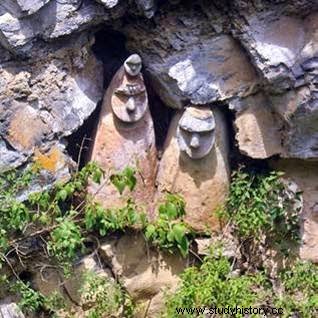
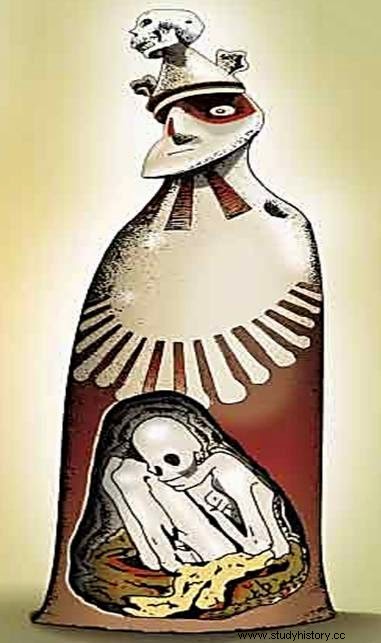 Karajia Sarcophagus C.- RELIGION AND ICONOGRAPHY Their gods were the snake, the condor and the jaguar, which were represented in architecture; as the snake is symbolized by the zigzag friezes, and the eye of the jaguar by the rhomboid friezes. The Chachapoyas worshiped water to the utmost and understood that it was the giver of life, since it fertilized their fields, valleys and forests, giving them the necessary sustenance. They probably saw in the rivers a cosmic serpent moving through their territory. The Chachapoya oriented their ceremonial centers, houses and mausoleums towards the lakes and lagoons that were considered places of origin or pacarinas. Serpents, monkeys, felines and birds were important beings within the Chachapoya cosmovision. The serpent represented in zigzag is the most popular design. When studying the iconographic representations of the Chachapoyas region, it can be a bit difficult to recognize which were original and which were imposed by the Incas. Despite this, the researcher Peter Lerche has identified the three main figures of importance to the people of this period, which are represented in a large number of objects and places.
Karajia Sarcophagus C.- RELIGION AND ICONOGRAPHY Their gods were the snake, the condor and the jaguar, which were represented in architecture; as the snake is symbolized by the zigzag friezes, and the eye of the jaguar by the rhomboid friezes. The Chachapoyas worshiped water to the utmost and understood that it was the giver of life, since it fertilized their fields, valleys and forests, giving them the necessary sustenance. They probably saw in the rivers a cosmic serpent moving through their territory. The Chachapoya oriented their ceremonial centers, houses and mausoleums towards the lakes and lagoons that were considered places of origin or pacarinas. Serpents, monkeys, felines and birds were important beings within the Chachapoya cosmovision. The serpent represented in zigzag is the most popular design. When studying the iconographic representations of the Chachapoyas region, it can be a bit difficult to recognize which were original and which were imposed by the Incas. Despite this, the researcher Peter Lerche has identified the three main figures of importance to the people of this period, which are represented in a large number of objects and places.The chronicler Valera says that the Chachapoyas worshiped snakes and that they had the condor as their main god. Lerche believes that condor worship was introduced by the Incas. If this were so, the friezes of Pajatén that represent condors would have been made during the Inca domain.
The serpent is represented as a zigzag in the friezes of the circular buildings. The zigzag is precisely the most widespread design in the geographical area controlled by the Chachapoyas and its presence in various mausoleums would indicate a relationship between the serpent and the ancestors.
Another symbol related to the ancestors would be the T shape used in some niches of burial chambers such as those of Revash. It also appears on the face of some Chepuric sarcophagi. The wooden idols known as the pinchudos carry the same symbol on their heads, only inverted. Lerche thinks that the male sex is related to the cult of the ancestors.
Rhombuses and fretwork are forms that frequently appear in the architectural friezes of the Chachapoyas culture. Some researchers link them to the female sex.
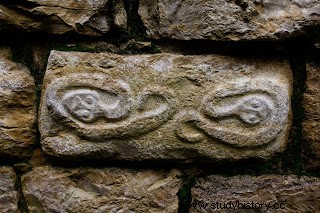
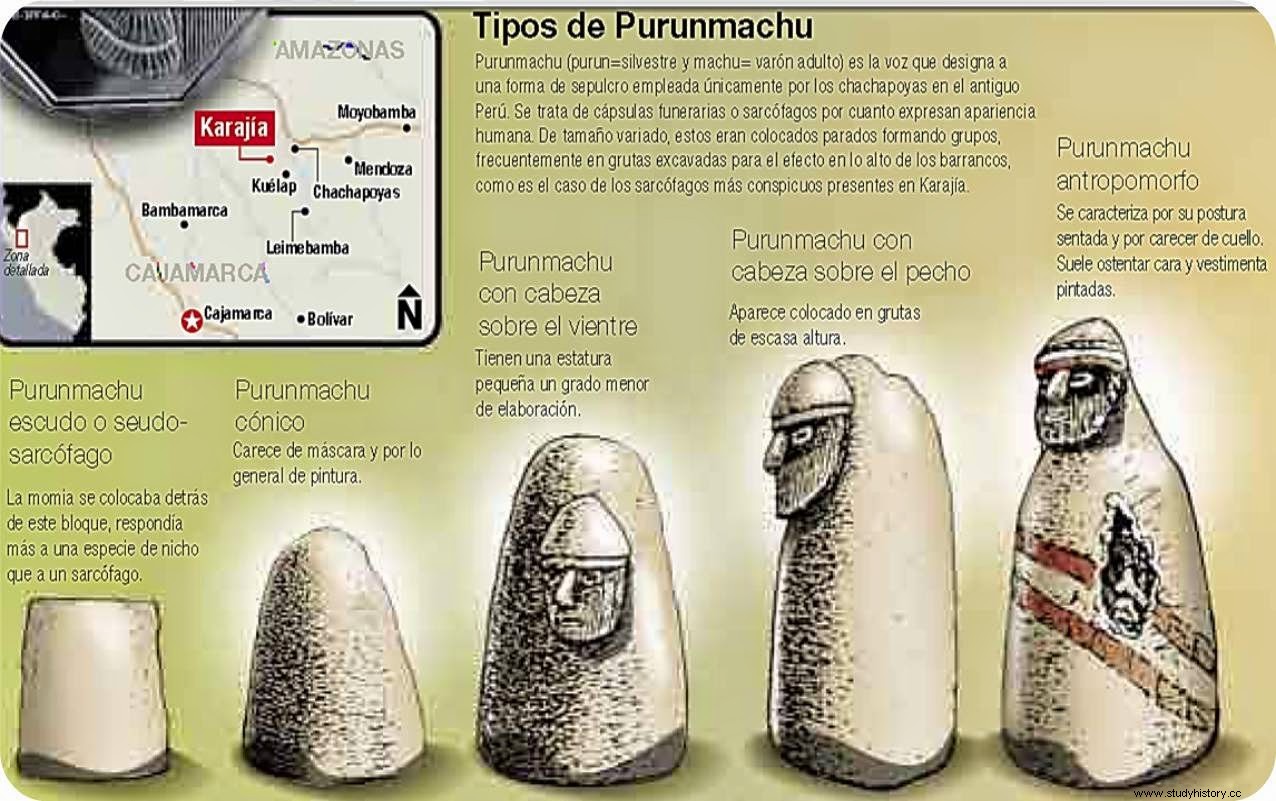 The Purunmacho D. CERAMICS. It is crude and a good instance of what is found is utilitarian, simply worked. The Decorating Techniques were stamping, stippling and incised Technique. The vessels had appliqué bands on the rims; some have incisions or small bumps on the body.
The Purunmacho D. CERAMICS. It is crude and a good instance of what is found is utilitarian, simply worked. The Decorating Techniques were stamping, stippling and incised Technique. The vessels had appliqué bands on the rims; some have incisions or small bumps on the body.E.-TEXTILERIA They were skilled textile makers who mastered tapestry, embroidery, painted weaving, and the art of feathers, using fine fibers from camelids and cotton, worked on backstrap looms with sewing tools such as spindles, needles, etc. Their garments were finely adorned with drawings of snakes, birds, monkeys and felines, where ocher, brown, red, yellow, black and white colors predominated, coming from trees and plants.
F.- END OF THE INCA CONQUEST The first Spanish chroniclers indicate that, at the time of the Inca conquest, the Chachapoya territory was divided into several cacicazgos with their own clans. It was a segmented society but with a homogeneous structure marked by architecture, ceramics and agriculture. For administrative reasons, the Inca unified these clans under the name of Chachapoya.
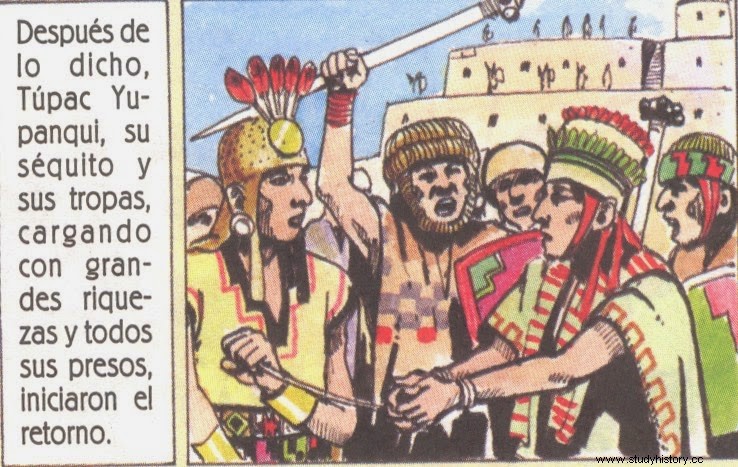 The Inca conquest of the Chachapoya territory began around the year 1470, when the sovereign was Túpac Yupanqui, who had to make great efforts to break the resistance and ferocity of the Chachapoya, however the incorporation was not total. To the messengers that were sent by the Inca to offer war or peace, the Chachapoya responded that they were willing to take up arms and die in defense of their freedom. When Huayna Cápac assumed command of the Inca Empire, he made several attempts to complete the conquest of the Chachapoyas, but the bravery of that people forced the imperial hosts to return to Cusco on two occasions to rearm their troops. ask for peace To strengthen his power in the new domains and due to the bellicose nature of the newly conquered, Huayna Cápac implemented the system known as "mitimae", by which he sent a large number of Chachapoya settlers to Cusco and other regions of Tahuantinsuyo, placing new Inca troops in that place. Despite some Chachapoya rebellions in the times of Huáscar and Atahualpa, they were unable to throw off the Inca yoke. Upon the arrival of the Spaniards, they preferred to ally themselves with foreigners, through the famous "Hispano-chacha" alliance, instead of remaining under Inca rule.
The Inca conquest of the Chachapoya territory began around the year 1470, when the sovereign was Túpac Yupanqui, who had to make great efforts to break the resistance and ferocity of the Chachapoya, however the incorporation was not total. To the messengers that were sent by the Inca to offer war or peace, the Chachapoya responded that they were willing to take up arms and die in defense of their freedom. When Huayna Cápac assumed command of the Inca Empire, he made several attempts to complete the conquest of the Chachapoyas, but the bravery of that people forced the imperial hosts to return to Cusco on two occasions to rearm their troops. ask for peace To strengthen his power in the new domains and due to the bellicose nature of the newly conquered, Huayna Cápac implemented the system known as "mitimae", by which he sent a large number of Chachapoya settlers to Cusco and other regions of Tahuantinsuyo, placing new Inca troops in that place. Despite some Chachapoya rebellions in the times of Huáscar and Atahualpa, they were unable to throw off the Inca yoke. Upon the arrival of the Spaniards, they preferred to ally themselves with foreigners, through the famous "Hispano-chacha" alliance, instead of remaining under Inca rule.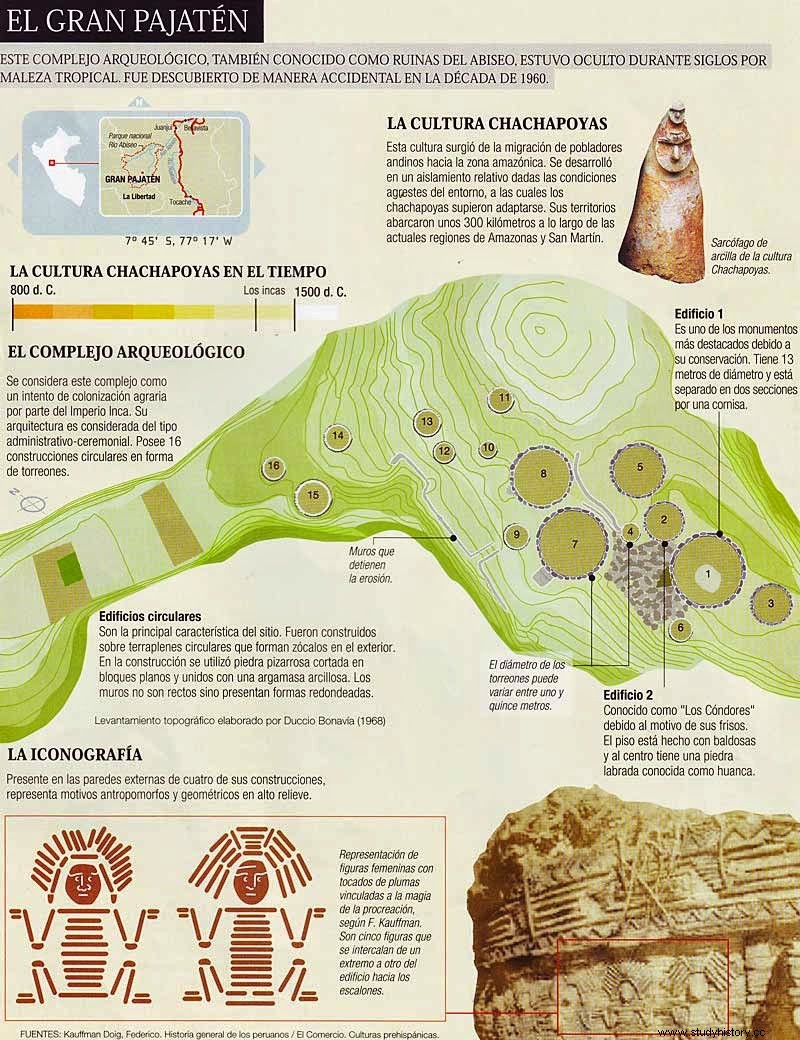
INVESTIGATIONS Numerous travelers and scientists such as Charles Wiener in 1864, Ernst Middendorf in 1865 and Antonio Raimondi in 1869, made the first descriptions of the region in the 19th century. The last century was made by Adolph Bandelier in 1907, Julio C. Tello in 1937, Louis Langlois in 1940, Henry and Paule Reichlen in 1950, Duccio Bonavia in 1968, Gene Savoy in 1970, Arturo Ruiz in 1972, Donald Thompson in 1974, Inge Schjellerup in 1984, Peter Lerche in 1986, Federico Kauffmann in 1988 and Alfredo Narváez in 1996. In recent years Adriana von Hagen did some studies on the Chachapoya in 2002, while Kauffmann and Narváez reinforced their research.
BIBLIOGRAPHY
- "The Chachapoyas" / Federico Kauffmann and Giancarlo Ligabue.
- "The Lost Kingdom" / AFP Integra.
- "The Kuelap Fortress" / Alfredo Narváez / Arkinka Magazine Nº 12 and 13.
- "The Chachapoyas and the Laguna de los Cóndores" / Adriana von Hagen.
- "Pre-Hispanic Cultures" / El Comercio and Ricardo Palma University.
- "The Chronicle of Peru" / Pedro Cieza de León.
- "Royal Comments of the Incas" / Inca Garcilaso de la Vega.
